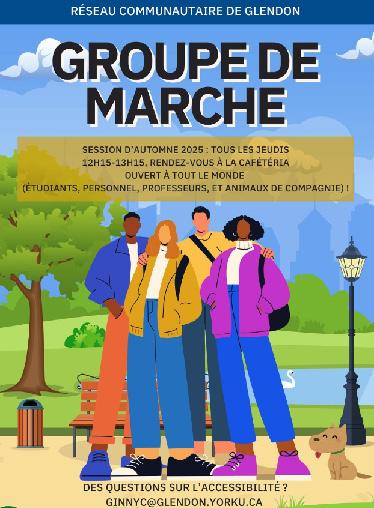




By Christina Savoiardo, Editor-in-Chief
Are you a student who is trying to get more involved in Glendon’s student life? Do you want to strengthen your leadership skills? Are you interested in meeting new people? Would you like to be part of a new student’s first memories at Glendon? If you answered yes to any of these questions, let me talk to you about Orientation Week and my experiences as a leader for the past 2 years.
If you’re a student who already participated in your own O-Week, you already know what I’m talking about. If not, I’ll explain. O-Week (or Frosh) is a week full of different activities and events planned for first-year students (as well as new Glendon students) for everyone to meet each other and get used to the new environment while having fun. During the week, students participate in many activities on the Glendon and Keele campuses for parties and additional events as well as off-campus to discover different locations in Toronto.

Whether you’re someone who enjoys dancing to music late at night or prefers staying in and doing arts and crafts, there is something for everybody during Orientation Week. Now, let me talk about my experience as an Orientation leader. I first considered becoming an Orientation leader in my first year when I saw a sign for it during the club fair. At first, I wasn’t really sure because I was kind of shy, and it wasn’t something I was comfortable doing at the time. However, after I experienced O-Week during my first year, I felt like I wanted to do it again because I had a good time and I enjoyed meeting so many new people. When applications opened, I decided to sign up to become a leader without expecting too much, but little did I know that I would make such lifelong memories and become closer to some of my best friends. I got to do many interesting cheers, I was able to help lead and participate in different activities and events and I got to meet many incredible students. It’s clear to see that my first year as an orientation leader was very special and that week holds so many unforgettable memories, such as NAVYYY (if you know, you know!). This year, at the end of August, I was able to participate in O-Week once again as a leader.
Yet another year of good memories, and I was lucky to be able to get to know so many cool new students and leaders. This year, we had our first Glenchella event, and it was a big highlight of the week for me. As someone who was very shy a lot of her life and felt uncomfortable being outgoing, I really encourage you to sign up to become an Orientation leader! Yes, it might sound scary, putting yourself out there in front of many students you probably don’t know. Nonetheless, I promise it is a very valuable experience. Being an orientation leader helps you gain new skills, such as leadership. You also get the opportunity to meet many new people, as well as get to discover some things about Glendon you haven’t heard about, such as clubs or useful services. Not to mention, it’s enjoyable! I truly recommend trying it out. You never know what moments might become part of your dearest memories and how much of an impact you can make on a student’s time at Glendon!
Editor In Chief/Rédactrice en chef
Christina Savoiardo
Chief of operations/Chef des opérations
Flo Iyam Tierra
Layout Designer/Maquettiste
Cynthia Xie
Editorial Assistants/Assistants éditoriaux
Julia de Leon
Samir Ahmed
Bianca Anderson
Nicholas Duarte
English Editor/Rédactrice Anglaise
Destiny Chan
French Editor/Rédactrice Française
Leanne Eyre
English Journalists/Journalistes Anglais
Connell Simkin-Watt
Gabriella Maitland
French Journalist/Journaliste Française
Paige Lalonde
Bilingual Journalist/Journaliste Bilingue
Geneviève Stacey
Afkaheen Alam

Bonjour Glendon!


Welcome to the first issue of Pro Tem for the year 2025-2026! I hope you are all ready for a great academic year ahead, filled with fun moments, new opportunities and stimulating learning experiences! From our Pro Tem team, we wish you the best of luck in your studies and all the success!
Ce premier numéro est plein de lectures variées et inspirantes! Nous avons une section d’expressions remplie de poésie, des conseils utiles pour vous préparer si vous pensez étudier à l’étranger, une réflexion sur si on avait un grand événement de collaboration entre les quatre grandes ligues de sports, et plus encore!
To all the new members of the Glendon community, welcome! We hope you have an amazing time here and that you’re ready for all the good that is to come this year. To all returning members, welcome back; we’re so happy to see you again! To all the members of Pro Tem, new or returning, thank you for being a part of our team, and thank you for all the hard work on this first issue. We’re excited to work with you and to create more cool issues throughout this year!

Restez à l’affux pour le 2e numéro! La prochaine date de contribution est le dimanche 5 octobre! Nous voulons inclure vos soumissions, donc si ça vous intéresse, envoyez-nous vos contributions sur Google Drive à editor@protemglendon.com. Pour plus de mises à jour et contenu, suivez notre Instagram @protemglendon!
Grab a warm drink and a snack, and enjoy our first issue of the year!
À bientôt! :)
Christina Savoiardo, Editor in Chief


Pro Tem is a unified organization that accepts and publishes articles from students, alumni, and community members. While we edit submissions for grammar and clarity, we stay true to each author’s voice and message. As an organization, we don’t endorse every viewpoint expressed; our goal is to amplify a wide range of perspectives within our community.
Avis de non-responsabilité!
Pro Tem est une organisation unifiée qui accepte et publie des articles provenant des étudiants, des anciens élèves et des membres de la communauté. Bien que nous corrigeons les soumissions pour la grammaire et la clarté, nous restons fidèles à la voix et au message de chaque auteur. En tant qu’organisation, nous n’endossons pas nécessairement chaque point de vue exprimé; notre objectif est d’amplifier une diversité de perspectives au sein de notre communauté.
Send us your articles, poems, reviews, opinion pieces, photos & more via Google Drive/ Envoyez-nous vos articles, vos poèmes, vos critiques, vos pièces d’opinion et plus via Google Drive: editor@protemglendon.com
Par Leanne Eyre, rédactrice française
Souffle nouveau chargé d’espoir dans l’air vif
Envie débordante d’un départ positif

Premiers jours brillent dans leur douce nouveauté
Tâches quotidiennes s’étirent et s’éteignent en beauté
Euphorie s’efface, le monde perd son étincelle
Matins frais comme le soleil glisse du ciel
Bientôt l’automne, puis l’hiver s’installera
Rêves de repos et de liberté d’été
Encore des mois avant la chaleur retrouvée
lolita
By Anonymous
he was very scared her wisdom was so intolerably poisonous to her body, which, was sweet to the taste;

By Anonymous
we prickled into spring— we prickled our love into spring tasting the frozen plating of a dish delectable in the cold weather just trying to get warm, warm enough to smell and to feel but, summer was delayed because of our cold hands, hands touching bodies warm from empathy a very unkind empathy and just as you told me love was easy, but decaying in my bedroom wall, so I stayed— even longer in the empty room to see you just once before the summer season
Nigiiminobimaatis
Par Paige Lalonde, journaliste française
Je me réconcilie
Qu'un jour je mourrai
Et j'ai peur
Que ce jour-là viendra
J'oublierai tout ce que ça signifiait d'être en vie
Je vais oublier que Nigiigizhewaadiz


sometimes, there is a poet's mouth that burns from the ugliest passion. disgust breeds a sensitivity that no longer serves the gulls of torture, mercy; dyadic in nature, daunting to the task of taking the man up the stairs, tell me sweet lullabies of women crying about men who served them in torn clothes and unwashed faces, dandelion greens and passion fruit opening ripe like fire lilies in summer heat born from the bitterness of warm milk and pantomiming sweet endearing predilections
Lolita was scared of her mother; she was very afraid of what she should become
By Leanne Eyre, French Editor
Just one amidst the branches
We all started the same
Basking tranquilly in the sun
Admiring the shaded picnics
Echoing the laughter from below
Until a chill ran down my veins
Change stirred in the crisp air
Chirping drowned in rustling leaves
Everyone seemed to know what to do
Growing up
Embracing their colours
Finding their way
I couldn’t choose mine
Blown from side to side
My friends began to take the leap
Bold and bright
A pile staring back at me
I wasn’t ready to fold
Still half green, half gold
But it got harder and harder to hold
They said just pick a colour

It’s really not that deep
Time was coursing through my veins
Hardening with every beat
I had to choose before the fall
No leaf can linger long
It’s autumn, after all
Je vais oublier que Nigiigotaaj
Je vais oublier que Nigiibizindam

Comme une langue dont le peuple s'accroche à son corps
Redonner vie à sa poitrine après que quelqu'un ait tenté de la tuer
Est-ce que ça vaut la peine d'essayer de le sauver?
Comme une culture à travers un continent
C'est différent partout, mais tellement pareil
Est-ce que je compterai pour les gens qui m'aiment?
Comme un peuple négligé
Sous la main ensanglantée de la disparition forcée et du silence
Est-ce que j'aurai la résilience de repousser le pied qui appuie sur mon cou
Et il menace de m'éliminer avant que j'aie fini?
Est-ce que je pourrai dire
Nigiiminobimaatis
J'ai eu une bonne vie.
Quand je suis rempli de ces questions
Comme du plomb dans mes mains et du feu dans ma gorge
Je me rappelle
Tant que j'essaie
Je suis vivant
Tant que j'apprends
Je ne peux pas mourir
Tant que je me donne
Alors je ne disparaîtrait jamais
Quand ma langue se sent déplacée dans ma bouche en roulant sur Anishinaabemowin
Que je trouve difficile de prononcer
Je suis vivant
Quand j'apprendrai l'existence de la grenouille qui a attendu son tour
Et nous a donné les cinq lunes de l'hiver
Je ne peux pas mourir
Quand j'écoute attentivement les phrases des êtres qui apprennent avec moi
Et m'offrir à eux
Je ne disparaîtrait jamais
Comme une langue
Je suis plus qu'une seule chose
Comme une langue
Je grandis et change constamment
Comme une langue
Je serai important pour beaucoup
Je fais partie de tous ces êtres
Les gens me connaîtront et je les connaîtrai
Et je me donnerai à eux
Et de cette façon
Comme une langue
Je ne mourrai jamais

By Gabriella Maitland, English Journalist
Since time immemorial, suffering1 has been a constant of life. Whether you’re an existentialist, nihilist, or someone towing the line, there is no running from this one single fact: suffering comes for us all. As if affirming Schopenhauer’s2 notion of “suffering being essential to life,” in some desperate effort to subsist, suffering and purpose became intertwined. Today, suffering is seen as something to propel us forward to find meaning. Since “comfort breeds complacency,” it almost seems like you’re not truly living if you feel no pain. Instead, to live well, one must suffer. But merely suffering is no longer enough. Rather, to live well, one must suffer well.
In 2021, the “I Hate The Letter S” essay began circulating on the internet after its author, Abigail Mack, was accepted into Harvard. Say what you want about Mack’s essay, but her vulnerability and how she turned an experience of loss into something greater are to be admired. Some might even say that, in the end, she was better off for having suffered. Though I don’t necessarily agree with that belief, the essay’s success led to an unsettling rise in what we now call “trauma essays.” To be clear, there is nothing wrong with sharing your experiences; after all, the basis of human nature is connection. My critique, however, begins with the belief that suffering leads to a higher purpose, or conversely, that suffering is the meaning of life. It’s not a stretch to believe that Mack’s essay aided in shaping the realization that it’s okay to share your negative experiences. However, due to our consumerist society, others saw this as a way to sell suffering on the shelf. In fact, the rise of trauma essays made vulnerability mainstream. Choosing to voice your trauma is one thing, but with the 2023-24 Common App essay being set with a prompt of “recounting a challenge, setback, or failure,” it pushes the narrative that one must have suffered—and suffered well—to be truly successful. Some might say, “Well, no, the whole point of reflecting is to see what you’ve taken away from the experience.” Okay. Fine. But what if nothing was learned from that suffering? Does that not automatically dictate that only those who’ve found meaning in their suffering are the only ones who will be successful? As Kate Jacobs once said, “Sometimes suffering is just suffering. It doesn't make you stronger. It doesn't build character. It only hurts.” To me, society’s emphasis on finding significance in suffering is more about seeking solace in the fact that you have suffered than it is about finding purpose itself. Cue the strong dislike of “Nepo Babies.”

To be called a “nepo baby” implies that one has “gained success or opportunities through familial connections.”3 This is particularly true when those connections—such as actors or politicians—are already successful in their own right. At present, it seems like the only people whom individuals can’t ever seem to relate to are “nepo babies.” While criticisms of select individuals might be completely justified, loathing someone on the premise of something they cannot alter or control seems absurd (the same can be said of asking them to ignore the benefit). Criticizing the fact that these individuals do not work and that they often act as if their success was achieved through hard labour is a common theme among comments on social media platforms. However, this argument only highlights the personal shortcomings of certain individuals and is not a representation of all “nepo babies.” As outsiders looking in, how exactly do we know how much work they’ve put into their careers? The standard defence is as follows: “Their parents gave them money and connections, while I had to work hard for everything I have.” But does this not echo the sentiment that success is more meaningful when you have to suffer for it? Every debate essentially boils down to this: “You” suffered for your opportunities, and they didn’t. The discourse against nepo babies stems from society’s attribution of higher purpose to suffering. When we see people get the things we’ve wept and bled for, with seemingly no effort, it causes us to think on our own experiences. If enduring adversity isn’t necessary for a good outcome, does that mean suffering is meaningless, or that I suffered for no reason?
(continue to page 7)
1: Noelia Buenos-Gómez, “Conceptualizing Suffering and Pain,” Philosophy, Ethics, and Humanities in Medicine 12, no. 3 (2017): https://doi.org/10.1186/s13010-017-0049-5.
2: John Messerly, “Summary of Arthur Schopenhauer’s, ‘On the Sufferings of the World,” https://reasonandmeaning.com/2015/11/17/arthur-schopenhauer-on-the-sufferings-of-the-world/.
3: Merriam-Webster Dictionary, “Nepo Baby Definition & Meaning,” https://www.merriam-webster.com/dictionary/nepo%20baby.
By Gabriella Maitland, English Journalist
This ideology of placing suffering on a pedestal is further observed in the Netflix original, BoJack Horseman. Despite largely being regarded as a “silly comedy,” the show is perhaps the best take on the complexity of human emotion that has ever been presented in media. Although the show’s focus is the former '90s sitcom actor, BoJack Horseman, he’s not who I’ll be talking about today (for those of you who know me, this must come as a shock). Instead, the focus is on a character called Diane Nyguen. In the tenth episode of season 6, “Good Damage,” Diane attempts to grapple with her past trauma by writing and publishing a book of essays.4 Up until the episode’s end, the overarching theme of suffering is presented to us as noble. Diane’s search for meaning isn’t because she feels, “all the time, like a garbage fire.” It’s because she believes it can help others who’ve been at the same lows that she has been in the past. Though this may be true, one can recognize that writing a book of essays detailing all your suffering isn’t the only way to do this. And, ultimately, Diane finds the feat of finding meaning in her suffering to be more difficult than anticipated. Ever the stubborn character, however, she tries everything, including ditching her antidepressants, to make a muse out of her pain, which worsens her situation. In keeping with the tortured artist trope, Diane is so consumed with analyzing and making sense of her misery that she doesn’t even realize that the whole day has passed her by.5 Naturally, this creates more suffering because the lack of found meaning implies that “[a]ll the damage [she] got isn’t good damage; it’s just damage. [She has] gotten nothing out of it, and all those years, [she] was miserable for nothing (…) [She] could’ve been happy this whole time.” Diane’s belief that her “good damage” is what makes her special is not new.6 In addition to it being a longstanding belief that many hold, it also dates back to the 1980s.
Positive reappraisal, as it's called, “is a form of meaning-focused coping which involves reinterpreting events or situations in a positive manner.”7 Although it can be helpful for reframing bad memories and even stressful events in a more positive light, the act of constantly trying to find meaning in your suffering can lead to what we call the Sunk Cost Fallacy. Whilst typically attributed to drinking or gambling, the fallacy is explained as “the tendency for people to continue an endeavour or course of action even when abandoning it would be more beneficial. Because we have invested our time, energy, or other resources, we feel that it would all have been for nothing if we quit.” I suppose we are all addicts in this way. However, instead of society staging an intervention, it instead packages this idea of “suffering well” in so many different phrases as we grow up: “What doesn’t kill you makes you stronger,” “Everything happens for a reason,” “Trauma builds character,” “No pain no gain,” “Bring back starving artists,” etc. But why can’t suffering just be something we go through?
Moving on can often feel like abandoning who you were in the past—but you’re not. You don’t have to suffer well for what you endured to be valid. “It takes a long time to realize how truly miserable you are, and even longer to see that it doesn’t have to be that way.” (BoJack Horseman, 3x03) While it’s true that some people do “grow” after having suffered, that growth is not truly attributable to suffering. They grew because they decided to act. In the same way comfort can lead to complacency, so can suffering. Society markets the idea that the more you suffer, the better you’ll come out in the end, but it’s not the suffering that gets you where you want to be. It’s the decision to act. We don’t know how much time we have here on Earth. If you suffer your whole life, when will you find the time to live? I’m not saying to forget or just abandon your past experiences—I know it’s not that easy. However, you shouldn’t let your need to make meaning from personal suffering be the thing that blinds you to the path that allows you to truly live well. A Reddit comment in the BoJack Horseman subreddit once said, “Art doesn’t have to be deep or depressing or pessimistic to contribute something to the world.”8 Your suffering is, and was valid, but it’s okay if it’s over now. Suffering might be an important facet of life, but the attribution of suffering to purpose is severely misplaced. There will be days when you look back, but right now, come into your own. Don’t let suffering be a child cradled at the back of your mind. You don’t need to stay stuck in a loop of meaning made out of suffering—and you certainly don’t need to suffer well.

4: Bojack Horseman, season 6, episode 10, “Good Damage,” directed by James Bowman, aired January 31, 2020, on Netflix.
5: Zoë Harris, “The Dangerous Allure of the ‘Tortured Artist’ Trope,” https://bdspotlight.com/opinion/2022/08/24/the-dangerous-allure-of-the-tortured-artist-trope/.
6: Clement Yong Hao Lau, and William Tov, “Effects of Positive Reapprisal and Self-Distance on the Meaningfulness of Everyday Negative Events,” Frontiers in Psychology, (2023): https://doi.org/10.3389/ fpsyg.2023.1093412.
7: Kassiani Nikolopoulou, “What Is the Sunk Cost Fallacy? | Definition & Examples,” https://www.scribbr.com/fallacies/sunk-cost-fallacy/.
8: Unknown Author, “BoJack Horseman - 6x10 “Good Damage” - Episode Discussion,” https://www.reddit.com/r/BoJackHorseman/.

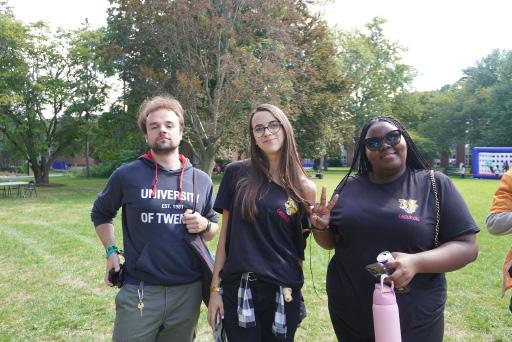














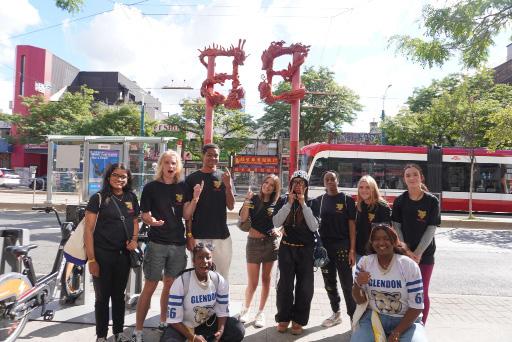

Photos prises par les leaders d'Orientation 2025!
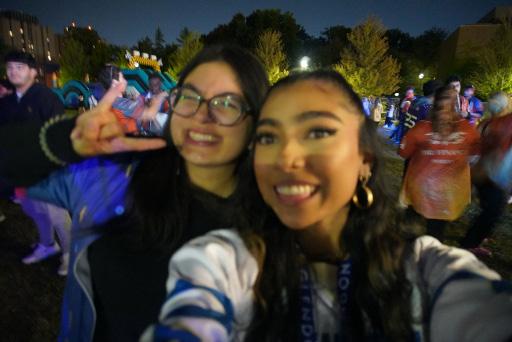



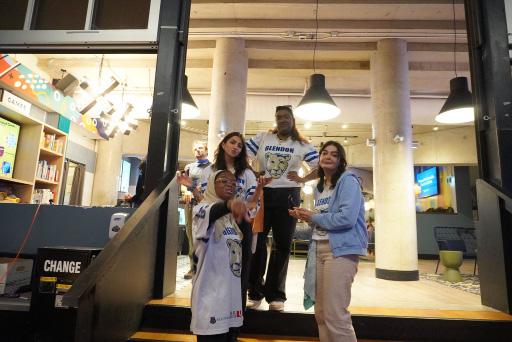




Par Paige Lalonde, journaliste française

Début septembre, le même jour où j'ai senti pour la première fois cette année la fraîcheur de l'air d'automne, je parlais à une amie d'un ami qui habite au nord de la ville. Elle me parlait de son amour profond pour les randonnées et de la façon dont elles lui inspirent une admiration pour la beauté de la terre. J'adore les randonnées, alors je lui ai dit que je ressens la même chose, surtout quand elles me permettent d'admirer la splendeur des couleurs d'automne. Elle m'a demandé où je faisais de la randonnée, et je lui ai parlé de plusieurs sentiers que je fréquente à Toronto. Plutôt que de réagir positivement, elle a fait quelque chose d'un peu étrange : elle a ricané et a levé les yeux au ciel.
Sa réponse m'a appris quelque chose sur les perceptions de cette ville, auxquelles je réfléchis encore : beaucoup trop de gens croient qu'on ne peut pas vraiment se connecter à la nature à Toronto. La nature – le monde des êtres vivants, du plein air, des arbres, du ciel, de l'eau et des animaux – prospère dans cette ville que j'aime, plus que dans la plupart des autres métropoles. Et maintenant, en cette saison de mort belle et colorée qui mène à une nouvelle vie, c'est le moment parfait pour partager quelques randonnées urbaines qui ont été mes véhicules vers d'innombrables moments d'appréciation dans la nature.
Les Brick Works de Don Valley
Pour les Torontoniens, cette suggestion est probablement la plus évidente des randonnées urbaines. Pièce maîtresse du centre-ville, la luxuriance de la Don Valley est un miracle pour une ville de cette taille. Les Brick Works est un parc et un site historique situé dans la Don Valley et une randonnée partant du quartier Rosedale est la meilleure façon d'y arriver. L'entrée de Milkman's Lane se trouve sur South Drive, à quelques pas de la station de métro Sherbourne. La restauration du réseau de viaducs Prince Edward, qui a rouvert en 2025 et relie les parties nord et sud de Glen Road, rend cette randonnée l'une des plus accessibles en transport en commun dans la ville.
Des pentes abruptes, couvertes d'arbres, mènent à un sentier forestier le long du Don Valley Parkway, qui s'ouvre finalement sur la Brick Works. L'espace vert fonctionne comme un système de filtration des eaux pluviales où l'eau est détournée de Mud Creek et filtrée à travers trois bassins naturalisés qui purifient l'eau avant qu'elle rejoigne la rivière Don. On trouve aussi dans le parc des bâtiments historiques construits à la fin du dix-neuvième siècle, lorsque les Brick Works était un site industriel qui fabriquait des briques pour plusieurs monuments célèbres de Toronto.
Les randonneurs de Brick Works découvriront une grande variété d'éléments dans cet espace. Au-delà des bâtiments historiques, l'un des nombreux sentiers pavés monte et contourne une colline offrant une vue sur la silhouette de la ville. Au bas de la colline, le sentier continue, passant devant chacun des trois étangs qui filtrent le ruissellement de Mud Creek. Le parc regorge de faune de toutes sortes : des pins qui fournissent de l’ombre, et des tortues, serpents, oiseaux et poissons que l’on peut facilement repérer dans les étangs et à leurs abords.
Parc national urbain Rouge
Ce parc national est unique au Canada : entièrement enclavé dans les limites urbaines. Il abrite la plus grande zone humide restante de la ville et offre quatorze sentiers de randonnée vraiment distincts avec des vues variées, allant des marais aux boisés et aux plages. Le sentier forestier en particulier enveloppe les randonneurs dans la forêt, créant une sorte de « silence bruyant » où les sons de la vie urbaine sont engloutis par les arbres, ne laissant derrière eux que des oiseaux chantants et des créatures bondissant à travers des feuilles mortes.
En octobre, ces sentiers sont à couper le souffle. La broussaille filtre la lumière à travers un orange velouté et crée des projecteurs dorés sur le sol forestier. Du haut des Bluffs offre une vue magnifique sur la rivière Rouge qui serpente en contrebas. De charmants bancs pastoraux apparaissent parfois le long des sentiers pour des moments de repos paisible.
Le côté sud du parc est accessible via la ligne d'autobus 54A depuis la station Eglinton, tandis que ses autres corridors sont accessibles par Rouge Hill GO ou par les autobus depuis les stations Kennedy ou Don Mills en direction du zoo.
Bien que Rouge se suffise à lui-même, il y a des points d'intérêt à proximité qu'il ne faut pas négliger. Morningside Park est le plus grand parc municipal de Toronto (oui, même plus grand que High Park), et une grande partie de sa vaste taille provient de ses magnifiques sentiers qui longent Highland Creek. Elle relie le campus de l'USTC, qui offre lui-même d'impressionnants sentiers boisés.
Le ravin Glen Stewart
Si vous cherchez une randonnée urbaine qui met en valeur son attrait urbain, le ravin Glen Stewart est exactement ce qu’il vous faut. Situé dans le quartier Beaches de Toronto, ce vallon est accessible par une série de hauts escaliers qui vous mènent profondément au sol de la forêt. Même si vous n'êtes qu'à quelques pas de la route du tram 503, les arbres de ce ravin boisé sont si hauts et imposants qu'on peut brièvement en perdre de vue. Les vues ici semblent sorties d'un conte de fées.
À l’automne, les bouleaux prennent une beauté saisissante, alors que le noir de leur écorce dichromatique s'assombrit et s'épluche. Les jardins des maisons situées au bord des falaises vous regardent, semblant à la fois équilibrés et sur le point d'être reconquis par la nature sauvage. On marche le long d'une passerelle qui s’élève au sommet du ventre paillé de la forêt, dégageant un parfum boisé réconfortant et des éclats de feuilles jaunes.
Comme aucune autre randonnée en ville, celle-ci donne l'impression d'avoir plongé dans la nature sauvage invisible de Toronto. À l'horizon, dans toutes les directions, on aperçoit des maisons et des devantures qui dépassent, rappelant qu'on est au centre vibrant de la quatrième plus grande ville d'Amérique du Nord ; néanmoins, le monde vivant des arbres et des animaux prospère à chaque recoin de cette ville.
By Connell Simkin-Watt, English Journalist




Imagine a world where the biggest stars from the NBA, NFL, NHL, and MLB unite for a multi-sport extravaganza. This would not just be another exhibition game. Instead, it would be an event where the athletes from the four major leagues compete in basketball, football, hockey, and baseball. Each league would contribute a set of its best players to form mixed teams that compete across all four sports. Players would be given the chance to showcase their athleticism in ways never before seen. This concept would be akin to the Olympics but elevated to a whole new level. The best athletes from the biggest leagues in the world would compete for eternal glory. Organizing such an event would be challenging. Ideally, it would be organized every two years during the offseason to allow players to recover. Fans would get the opportunity to see their favourite athletes in entirely new roles. The idea is simple: bring together the most exciting athletes from four of the world’s most popular sports, and let them prove their versatility and athleticism. The concept is exciting and fun and could ultimately generate interest for all the leagues involved.
The Structure of the Event
The event would feature teams made up of players from all four leagues. Each team competes in four distinct sports: basketball, football, hockey and baseball. The players would be split into four random teams to ensure an equal playing field. The teams would compete in round-robin tournaments for each sport, with points awarded for victories and impressive performances. The structure would ensure the competition remains tight, and fans would have a reason to stay engaged throughout.
The event could span over two weeks, with each sport being played for a few days. The teams would compete in basketball, football and hockey on separate days. Baseball would be reserved for the final stretch. After the round-robin tournament, the top teams would enter a knockout phase, with the teams seeded from one to four based on performance in the round robin. This competitive format would be designed to reward teams that excel in all sports. This is why each team would be composed of a random selection of top players from the four leagues. To emerge victorious, a team would need to play at a high level in each sport. This would not only test the athletes’ abilities across various sports but also highlight their overall athleticism and adaptability.
Key Players and Storylines to Watch
Each of the four leagues brings its own set of athletes who could excel across multiple sports. From the NBA, Giannis Antetokounmpo would thrive in this type of competition. His combination of strength, athleticism, and speed would make him a dominant force in all four sports. LeBron James, with his experience in football and unmatched basketball skills, would also make an immediate impact in multiple areas. The speed of fast point guards like Ja Morant and De’Aaron Fox would make them dangerous at positions such as running back in football, shortstop in baseball and forward in hockey. Lastly, Zion Williamson would also be unstoppable at tight end, provided he’s not injured.
In the NFL, Myles Garrett and DK Metcalf would be unstoppable. Both athletes are exceptional in terms of size and athleticism. They would be capable of excelling in basketball, baseball, and possibly even hockey. Quarterbacks like Patrick Mahomes and Kyler Murray would prove their baseball roots in both baseball and football. Mahomes played baseball in addition to football at the university, and Murray was even drafted by the Oakland Athletics. Players like T.J. Watt and Derrick Henry would make extremely intimidating enforcers in hockey. The player who, in my opinion, is going to be the overall best NFL player in the tournament is Travis Kelce. His combination of size and speed makes him a very viable option in hockey, baseball and basketball in addition to football.
From the MLB, Shohei Ohtani would be a standout. He has demonstrated his versatility by excelling in both pitching and hitting. His athleticism and competitive edge would serve him well across the board. Aaron Judge, with his towering height and athleticism, would likely shine in basketball. His ability to use his size and reach would also come in handy in football or even hockey. Speedy players like Bobby Witt Jr. and Elly De La Cruz would be able to use their speed to their advantage as wide receivers, running backs, point guards or forwards. In the NHL, Tyler Myers’s height and agility would translate well to basketball and football. A role player in the NHL, his height would make him an asset in basketball. Sidney Crosby would also excel in basketball and football due to his quickness and intelligence on the ice. Auston Matthews, who regularly hits power shots in the NHL, would absolutely dominate at baseball. Brad Marchand and the Tkachuk brothers would have no trouble mixing things up in football. They would bring their tenacity and physicality from the ice to the gridiron.
In terms of additional key storylines, the possibilities are endless. We could see Tom Brady come out of retirement to take part in the event. We could also see Zdeno Chara, the tallest NHL player ever, come out of retirement to wreak havoc on the basketball court. There would be endless possibilities for iconic moments.
The Challenges
There would be many challenges in organizing such an event. The two primary concerns would be scheduling and injuries. Each league operates on its own seasonal timetable. This would make it difficult to find a window during which players from each sport can participate. To make this event possible, it would need to be held every two years during the offseason. This would give athletes enough time to recover between events. It would also allow for more media coverage and fan engagement. The Olympics operate on a similar timeline, providing a precedent for an event like this.
Injuries would also be a significant concern. Athletes would be competing in multiple sports, which would put extra strain on their bodies. To mitigate this, players could be rotated in and out during the competition. This would ensure overuse is prevented. Only certain positions would compete in particular sports. For instance, a quarterback from the NFL could only compete in football-related events, and big men from the NBA might not compete in hockey. Playing multiple sports in quick succession would also wear athletes down. To solve this, the competition could be spaced out over a longer time frame, with built-in rest days between events. This would also allow for media coverage, fan interaction and other marketing opportunities. All of which ensures that players are given enough time to recover between sports.
There would also be numerous benefits to this event. For fans, it would be a dream come true. They would be able to see their favourite athletes show off their skills in unfamiliar environments. The unique format would provide fans with excitement and unpredictability as they cheer for their favourite stars across all four major leagues.
This event would also generate massive revenue for each of the 4 leagues. The cross-promotion between the leagues would attract fans who may not typically follow all four sports. The event itself would provide an influx of sponsorship deals, merchandise sales, and ticket sales. Television ratings would skyrocket, and the event could become an annual sensation in terms of its global appeal. Something comparable to the Olympics or the FIFA World Cup. Furthermore, the event would showcase the incredible versatility and athleticism of the players involved. While stars like Giannis, Mahomes, and Ohtani would excel in multiple sports, fans would see how players from different backgrounds could adapt to new sports, making for compelling viewing. The athletes themselves would benefit from being able to showcase their skills in multiple areas, boosting their marketability and solidifying their place as some of the greatest all-around athletes of all time.
This concept has some similarities to existing events such as the Olympics and Celebrity All-Star Games, where athletes from various disciplines come together to compete. However, the stakes would be higher here. This event would feature actual professional athletes, not just celebrities or amateurs, making the competition more intense and meaningful. This would be like the Olympics on steroids. Imagine seeing LeBron, Brady, and Ohtani all playing in one tournament. It’s a spectacle waiting to happen.
Additionally, the idea is reminiscent of NFL and NBA All-Star events, but on a much grander scale. While the NFL and NBA have their own versions of celebrity games, this cross-sport collaboration would take it to an entirely new level. It would be the ultimate showcase of athleticism, competition and entertainment, with each league playing a vital role in making the event a global sensation.
Conclusion
In conclusion, a cross-league, multi-sport event featuring the best athletes from the NBA, NFL, NHL and MLB would create an unforgettable spectacle. This event would offer fans the chance to see their favourite athletes compete in basketball, baseball, football, and hockey. The challenges of scheduling, injuries, and fatigue are certainly significant. But these challenges can be overcome with a careful approach. This event would spawn countless thrilling moments, rivalries, and iconic highlights that could redefine an era of sports entertainment.
By Geneviève Stacey, Bilingual Journalist
Inspired by Black Forest Cake, here is my take on Black Forest Cookies! (Chocolate-cherry-marshmallow cookies didn’t sound as catchy.)
Makes about four dozen 2-inch cookies.
Ingredients:
• 1 cup brown sugar (If you don’t have any, use white sugar and add some molasses.)
• ½ cup white sugar
• 1 1/3 cups of canola oil, or another neutral baking oil
• ½ cup of your preferred non-dairy milk (It would also probably work with milk, though I haven’t tried using it.)
• 2 teaspoons xanthan gum
• 2 teaspoons vanilla extract
• ¼ cup of hot chocolate mix
• 3 cups all-purpose flour
• 1 teaspoon salt
• 1 teaspoon baking soda
• ½ cup cherry candies or dried cherries (or… whatever other kind of dried fruit you have on hand. Most work with the recipe.)
• ½ dark chocolate chips or chopped dark chocolate
• ½ cup chopped up marshmallows, or mini marshmallows (I used Dandies)
• Maldon salt (or pink salt, or sea salt, or, if you’re stuck, table salt)
Instructions:
1. Preheat the oven to 350°F. Lightly grease a large light metal baking sheet, or line it with a silicone baking mat.
2. Whisk together the sugars, oil, milk and xanthan gum for about two minutes. (You can use a whisk or a fork.) This is chemically relevant to the recipe, so be sure to mix for the correct amount of time. Add the vanilla and hot chocolate powder. It should look a little bit like chocolate fudge sauce.
3. Add the flour. You can either add it in one cup at a time or fold it all in at once. The important thing is that there are no lumps of flour once you’re done mixing.
4. Fold in the cherry element, chocolate, and marshmallows.
5. Roll the dough into walnut-sized balls, or use a cookie scoop. Place them on the prepared tray about 2 ½ inches apart. You can flatten them a bit if you want them to look more uniform. Add a sprinkle of Maldon salt to the top of each cookie.
6. Bake the cookies for 8-9 minutes. Remove them from the oven, and let them cool another 5-10 minutes before transferring them to a cooling rack to cool completely.



Par Leanne Eyre, rédactrice française
Si on m’avait dit, en première année, que je passerais un semestre entier en France, je ne l’aurais jamais cru… Je n'avais jamais mis les pieds en Europe, je ne viens pas d’une filière d’immersion française, je suis de nature timide et je ne voulais pas prendre du retard dans mes études. Malgré toutes les raisons possibles pour ne pas y aller, j’ai franchi le pas : j’ai saisi l’occasion de réaliser mon rêve de vivre une immersion complète dans la langue française !
En janvier 2025, je suis partie étudier à Angers, dans l’ouest de la France. Après des mois et des mois de recherche, de préparation, de candidatures et de démarches administratives, la réalité de ma décision m'a traversé l’esprit. Dans l’avion, en lisant une lettre écrite à la main par ma mère, j'ai enfin craqué, incapable de retenir mes larmes et de garder mon air courageux. La fatigue a fini par m'envahir, apaisant à la fois les turbulences de l'avion et mes doutes. Je vais partager cinq leçons que je retiens de mes cinq mois à l’étranger.
1. On ne peut pas tout prévoir.
J'ai atterri à Angers un dimanche après-midi, sans carte SIM française, sans Google Maps, sans internet. J’ai vite découvert que presque tout est fermé le dimanche : les supermarchés, les boulangeries, même la réception de ma résidence Crous. J’ai dû surmonter ma timidité et demander de l’aide à des inconnus, puis traverser la ville pour récupérer ma clé dans une autre résidence universitaire. Le lendemain, j’ai finalement acheté une carte SIM dans un tabac, après avoir été refusée par les grands opérateurs. C’était ma première leçon : on ne peut pas tout prévoir. On apprend en avançant.
2. Il faut s’adapter pour s’intégrer.
Pendant les jours d’orientation, j’étais prête à présenter les cours que j’avais choisis à partir du catalogue en ligne. À ma grande surprise, j’ai dû tout recommencer quand j’ai appris que les horaires changent chaque semaine, créant pas mal de conflits entre mes cours de mathématiques et ceux de français. Par exemple, j’ai eu un cours de statistiques cinq fois dans la même semaine, puis aucune séance pendant les deux semaines suivantes. Et les différences scolaires ne s'arrêtent pas là… Seules trois absences étaient permises par cours, sinon le semestre ne serait pas validé. La ponctualité était primordiale. Les notes, sur 20, étaient parfois déterminées par un seul partiel. J’avais laissé derrière moi mes repères, mes routines, tout ce qui m’a semblé « normal ». Mais le fait d’être hors du contrôle m’a appris à m’adapter, à lâcher prise et à accepter l’imprévu.
3. On récolte ce qu’on sème. Côté social, je me suis vite rapprochée d’autres étudiants internationaux. Mes deux plus proches amies viennent d’Espagne et d’Allemagne. Même si l’anglais aurait été plus facile, on a décidé dès le début de se parler en français, pour progresser ensemble. C’était plus lent au départ, mais à la fin du semestre, parler en français était devenu naturel, notre langue commune. On a partagé des plaisirs simples : tester de nouvelles pâtisseries, visiter des musées gratuitement grâce à nos visas étudiants, regarder le coucher du soleil et explorer des villes à pied ou à vélo. J’ai progressé en français en m'efforçant de parler en français et je me suis fait des amis en osant aller vers les autres, malgré ma timidité. Je crois fermement que l’expérience dépend vraiment de l’investissement qu’on y met.
4. Profite de l’endroit où tu es.
Les excursions – Mont-Saint-Michel, les châteaux de la Loire, Paris, Bruxelles, Londres… – sont les moments qui ont surtout marqué mon échange. Étant donné qu’au fond, faire un échange universitaire, ce n’est pas seulement suivre des cours dans un autre pays. On peut s’asseoir dans une salle de classe n’importe où dans le monde. Ce qui rend l’expérience si précieuse sont toutes les découvertes informelles, les conversations spontanées et les petits défis quotidiens. J’ai essayé de ralentir, de savourer chaque moment. Oui, j’ai étudié. Mais j’ai aussi fait des excursions le weekend, admiré des couchers de soleil sur la Loire, visité des musées gratuits, regardé des films français au cinéma, partagé des repas, pris des photos et écrit dans mon journal pour garder une trace. L’équilibre n’est pas un luxe, c’est essentiel ! Ce qu’on apprend en vivant pleinement son quotidien à l’étranger ne se trouve dans aucun manuel. 5. Fais-toi ta propre opinion.


Avant de partir, j'ai entendu toutes sortes de commentaires : « attention aux pickpockets », « les profs sont sévères », « tu n'obtiendras pas assez de crédits », « les Français sont froids »… Il y aura toujours quelqu'un pour semer le doute. Ce que j'ai vécu à Angers a été, dans l'ensemble, très positif. J'ai découvert une ville à taille humaine, avec ses petits cafés, son histoire riche, ses espaces verts et son ambiance étudiante. Bien sûr, il faut rester prudent et conscient de son environnement, surtout quand on voyage seul. En même temps, il faut aussi garder l'esprit ouvert. Je n'ai pas laissé les Cinq mois plus tard, je suis rentrée au Canada, convaincue d’avoir pris la meilleure décision de ma vie. Mon seul regret ? Ne pas avoir passé l’année entière en France. J’ai compris que pour tirer le meilleur d’un échange universitaire, il faut s’investir pleinement : oser, s’adapter et dire oui à ce qui sort du plan.
Aujourd’hui, je réalise à quel point cette expérience m’a transformée. J’ai découvert que rencontrer des gens et avoir des événements à attendre avec enthousiasme me rendent plus heureuse et plus productive dans mes études. J’ai trouvé en moi un côté plus aventureux, sociable et confiant que je ne soupçonnais pas du tout. Si l’occasion se présente un jour de repartir, que ce soit pour un autre échange de deuxième cycle ou même pour étudier en France, je n’hésiterai pas une seconde.




